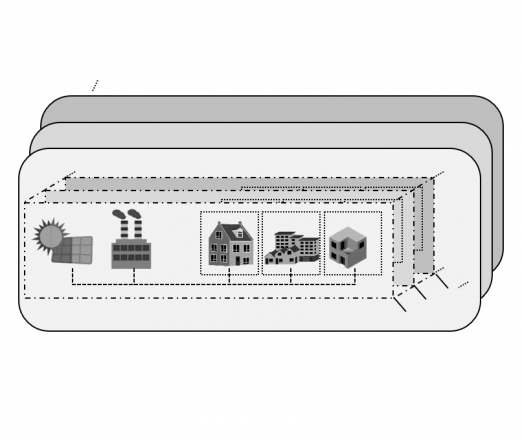Energy balance district tool
districtPH is an Excel tool for the optimisation of city districts in terms of energy efficiency. Its focus is on buildings and on the effects of refurbishment strategies. Supply structures and public consumers are also taken into account.
The tool considers the following contributions to the district's energy balance and their interactions.
- Heating, cooling, DHW, and electricity demand of buildings. Each building is assigned to a building type. A realistic assessment of the heating demand, using appropriate indoor temperatures, is the most important step of this analysis. In addition, districtPH calculates user-related energy consumptions like domestic hot water and household electricity.
- Refurbishment scenarios. The user can define the probability of a refurbishment to a certain efficiency level, depending on factors like component age, time, subsidies, or existing efficiency level. Based on these inputs, the course of the district's energy demand over time is determined. The difficulties arising from the probabilistic nature of refurbishment rates were solved by implementing a Monte Carlo simulation method.
- Energy production in buildings. Heating and hot water can be produced by different heat generators, including oil or gas boilers or heat pumps. Solar DHW and PV installations are accounted for.
- Energy production on the district level. The electricity and district heating networks are supplied by CHP plants, large solar thermal collectors, PV plants, and conventional heat and electricity generators. Short and long term storages are taken into consideration.
- Other electricity consumers. The structure of the electricity demand is supplemented by street lighting and the energy consumption of trams and electric motor vehicles.
Each consumer and producer has its own time schedule, which is important in matching supply and demand, e.g. with renewable energy production or demand response.
The implementation as a spreadsheet program has considerable advantages for practitioners: All calculation steps are accessible and transparent. The user can easily add auxiliary calculations, results tables and diagrams, and further extensions. Neither installation nor specific software skills are required, the tool itself can be passed on from the consultant to the client for further reference.
Questions such as 'What is required to make the district zero-energy?', 'What would be an appropriate size for a seasonal heat storage?', 'How much energy will be exported from the district in a specific situation?' can be addressed. Possible results also include the total primary energy demand or the CO2emissions over several decades, depending on different scenarios for e.g. retrofit subsidies or district heating network installations.
districtPH thus enables the user to investigate, with reference to arbitrary performance indicators, the long-term consequences of planning decisions.
